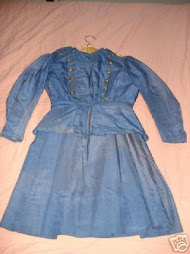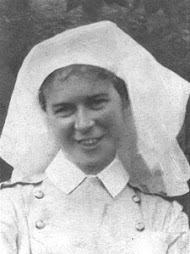I apologize for being late with my blog once again. I've ordered some new materials on some of the Canadian nurses who died during the Great War. However, those records haven't yet arrived. So, in their stead, I'm going to review two books on four intrepid women who served on the battlefronts of that conflict. The first book is Elsie and Mairi Go to War: Two Extraordinary Women on the Western Front by British historian, Diane Atkinson (London: Arrow Books, 2009--paperback edition, 2010). The book describes the experience of two of the most famous women of the war, British born Elsie Knocker and Mairi Chisolm. The two women served in Belgium with "Dr. Hector Munro's Field Ambulance" under battlefront conditions. Both women began their service in September 1914 and stayed until they were nearly killed in a gas attack in March 1918. At the beginning of the war, Mairi was just 18 years old and Elsie was 30, a divorcee and mother of a young son. They met at a motorcycling event in 1913 (both women were avid motorcyclists)and when war was declared, decided to offer their services. In the early months of the war, they were stationed near Ghent, Belgium and then found themselves on the run from German troops, sometimes so close to the action that they witnessed German bayonet charges. They came under fire often, sometimes when they were trying to save wounded men (from both sides) on the battlefield. The women eventually spent much of the war in a bombed out cellar in Pervyse, where they "lived, made soup and patched up the wounded." "The day started at six o'clock in the morning, when teh ladies got dressed (put their boots on and brushed their hair), lit the stove and made cauldrons of soup or hot chocolate, which they kept warm all day. They served it to the wounded soldiers they were looking after and otehrs who called in, and also took it in enamel pails at breakfast and in the evening to the men on teh sodden front line. They walked in the dark in the 'icy freezing stillness' without a light and in silence, whispering the password to the sentries, knowing the Germans were not far away." Elsie and Mairi Go to War is an excellent, informative read for anyone interested in the frontline roles played by some women during the Great War.
The second book I'm going to review is Battlefront Nurses in WWI by Canadian historian Maureen Duffus(Victoria: Town and Gown Press, 2009). Duffus' book focuses on two British Columbia nursing sisters--Elsie Collis and Ethel Morrison. This is an excellent book for anyone interested in the personal experience of those Canadian nurses who served on many different fronts, including England, Salonika, on hospital ships in the Mediterranean, and in hospitals along the lines of communication in France. Duffus' interest in these two nurses began with the rediscovery of old wartime photo albums--one that had belonged to her aunt Ethel Morrison, the other that once belonged to Morrison's colleague Elsie Collis (now in the hands of her daughter Barbara Randall). Duffus combines the photos, Collis' diary, Morrison's memoir, with her own research and produces a vivid picture of the lives of these two women as well as the staff of No. 5 Canadian Gerneral Hospital. In previous blogs I described the destruction of the large military hospital complex at Etaples. Collis wrote many diary entries describing the raid: "Before I left for supper I heard distant guns but thought nothing of it. had just got to the kitchen door when bombs began to drop. There were several in the mess quarters and set the rows of huts on fire. Two dropped outside the [nurses'] club, another outside our new quarters. Teh whole place was wrecked--poor little 'Bob' [Gladys Wake] was buried, she had a fractured femur, a huge wound in the other leg and several smaller ones. A Miss [Katharine] McDonald was killed. She had a tiny wound, but it must have severed the femoral artery as she died of haemorrhage almost immediately..." Collis continues with a vivid description of the raid and its aftermath. The book also contains a list of those Canadian women who received the Royal Red Cross award, as well as a list of all BC Graduate nurses who served durign the war. A fascinating read and a great resource for anyone interested in Canadian nursing sisters.
Historian Annette Fulford also tells me that another regionally focused history of nursing sisters, is due out in October from Goose Lane Editions. It is entitled Agnes Warner and the Nursing Sisters of the Great War To read more about it, visit: http://www.gooselane.com/book/9780864926333. Watch this spot as well! I'm hoping to review it in a future blog.
On a final note; as soon as my records arrive, I will be writing more profiles of Canadian nurses who fell during the Great War. Until then, if you have any comments, suggestions, or pieces of history to share, please contact me and I'll post them here.
Subscribe to:
Post Comments (Atom)






















Hello Debbie,
ReplyDeleteI'm currently drafting a pattern for the CAMC nurses ward dress. Is the uniform pictured in your own collection?
Keen to show what Canada's women did here in the UK and in France/Belgium.
I was there last week and photographed a number of male CAMC graves nr Poperinghe.
kind regards
Kate.
Hi Kate. I'm not sure if you received my email, but if not, please let me know if you do create a pattern. I have wanted to do this myself and would be interested in this. Also, the uniform is indeed a part of my own collection--I also have the working uniform for Cecile McKibben. Thanks so much for commenting! Best regards, Debbie Marshall
ReplyDelete